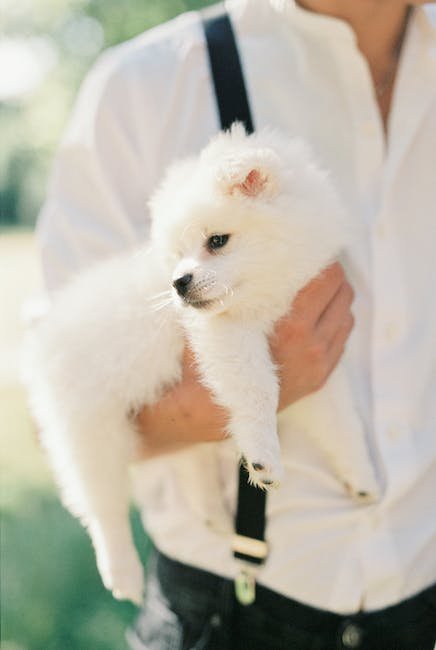Trepidatious tails tucked between trembling paws, a fear of brooms can plague even the bravest of puppies. With furrowed brows and wide-eyed apprehension, these pint-sized pooches behold the sight of a broom as if it were a menacing beast. But fear not, for we are here to sweep away their anxieties and help them conquer this common canine dilemma. In this article, we delve into the intriguing world of puppy training, exploring the art of taming their apprehension towards brooms and guiding them towards a life free from sweeping-related sorrows. So, if your furry companion trembles at the mere sight of a bristled handle, join us as we unveil the secrets to overcoming their broom-induced fears and restoring harmony to their playful paws.
Table of Contents
- Puppy Training for Fear of Brooms: Sweeping Away Anxiety
- Understanding the Root Causes: Unraveling the Fear of Brooms in Puppies
- Creating a Positive Association: Desensitization Techniques for Overcoming the Fear of Brooms
- Step-by-Step Approach: Training Exercises to Instill Confidence and Trust
- Patience and Persistence: Effective Strategies for Reinforcing Positive Behaviors
- Long-Term Support: Helping Your Puppy Maintain a Fear-Free Relationship with Brooms
- Q&A
- Closing Remarks

Puppy Training for Fear of Brooms: Sweeping Away Anxiety
Does your puppy cower in fear whenever you pick up a broom to clean? Is the simple act of sweeping causing them undue stress and anxiety? Fear no more! With a few simple training techniques, you can help your furry friend overcome their fear of brooms and sweep away their anxiety for good.
Here are some practical steps to get started:
1. Positive Reinforcement: Create positive associations with the sight and sound of a broom by rewarding your pup with treats or praise whenever they show calm behavior near it. Gradually increase the proximity to the broom as their confidence grows.
2. Desensitization: Gradually expose your puppy to the broom in a controlled and safe environment. Start by placing the broom in a corner of the room and allowing your puppy to approach it on their own terms. Reward them for any signs of curiosity or bravery. As your pup becomes more comfortable, progress to gently sliding the broom back and forth – reminding them it’s just another harmless object.
3. Playful Interaction: Engage your puppy in interactive play using a mini broom or a broom-like toy. Incorporate fun activities that associate the broom with playfulness and positivity. This will help replace their fear with a more positive outlook.
No need to sweep your pup’s anxieties under the rug any longer! By implementing these gentle training methods, you can help your puppy overcome their fear of brooms and restore their confidence in no time. Remember, patience and consistency are key to success in puppy training. So, let’s sweep away their anxiety and make cleaning time a stress-free experience for both you and your furry companion!
Understanding the Root Causes: Unraveling the Fear of Brooms in Puppies
Brooms, the seemingly innocent household cleaning tool, can sometimes instill a deep fear in puppies that leaves pet owners perplexed. Unraveling the root causes behind this fear can help us provide a calmer and more comfortable environment for our furry companions. While each puppy is unique, there are a few common reasons why they may develop an aversion to brooms.
1. Traumatic experiences: Some puppies may have had negative encounters with brooms in their earlier stages of life, which could have left a lasting impression. It could be a loud noise caused by the bristles on a hard surface, accidentally being hit by a broom, or even witnessing someone using a broom aggressively. Understanding whether your puppy has experienced any traumatic incidents related to brooms can help address their fear with sensitivity and patience.
2. Natural instinct: Puppies have a natural instinct to be cautious of unfamiliar objects, especially those that resemble potential threats. Brooms, with their long handles and strange bristle structures, can trigger this cautious behavior. It is important to create positive associations with brooms early on to prevent fear from escalating. Gradual exposure, accompanied by treats and rewards, can help puppies develop a more relaxed attitude towards these unfamiliar objects.
2. Lack of socialization: Proper socialization during a puppy’s crucial development period is crucial in preventing fear-related behaviors. If puppies are not exposed to different objects and situations, they may develop fear and anxiety towards new things, including brooms. Encouraging positive interactions with various objects, including brooms, can help build confidence and reduce the fear response.

Creating a Positive Association: Desensitization Techniques for Overcoming the Fear of Brooms
For those who experience an irrational fear of brooms, overcoming this phobia can be a liberating experience. Desensitization techniques can help recondition the brain’s response to brooms, allowing individuals to gradually face their fears and create a positive association with these everyday objects.
1. Start with Visualization: Begin by visualizing positive scenarios involving brooms. Close your eyes and imagine yourself calmly in a room with a broom nearby, feeling relaxed and at ease. Repeat this visualization exercise regularly to reinforce positive associations.
2. Gradual Exposure: Gradual exposure is key to desensitization. Start by keeping a broom in sight from a distance, allowing yourself to progressively approach it over time. Gradually decrease the distance until you feel comfortable enough to touch the broom. Celebrate each milestone achieved along the way.
3. Positive Reinforcement: Positively reinforce your progress by rewarding yourself for each successful step taken towards overcoming your fear. Treat yourself to something you enjoy after completing a desensitization session. This helps to associate the experience with positive emotions, further reinforcing your newfound comfort around brooms.
Remember, overcoming a fear takes time and patience. Consistently practicing these desensitization techniques can empower you to conquer your fear of brooms and live a fear-free life!

Step-by-Step Approach: Training Exercises to Instill Confidence and Trust
In any relationship, whether human or animal, confidence and trust serve as the pillars for a strong bond. Here, we present you with a step-by-step approach to training exercises that will help foster these essential qualities, creating a foundation for a harmonious and secure connection.
Exercise 1: Building Confidence through Positive Reinforcement
To begin this journey, establish a safe and encouraging environment. Start by rewarding your partner’s simple achievements, using positive reinforcement techniques such as treats, praises, and gentle strokes. Consistency is key; repeat this exercise regularly while gradually increasing the complexity of the tasks. Observe how their confidence grows as they receive positive feedback and attention.
Exercise 2: Strengthening Trust with Communication
Trust is built upon clear and effective communication. Engage in exercises that improve your partner’s response to cues and commands. Focus on cues that are relevant to their safety and well-being to build a foundation of trust. Encourage eye contact, prompt reactions, and reward their efforts generously. By effectively communicating your expectations and ensuring a positive outcome, trust will naturally flourish.
Exercise 3: Overcoming Fear through Gradual Exposure
Fear can hinder both confidence and trust. To address this, devise a gradual exposure exercise. Identify the specific fear trigger and introduce it in a controlled and safe manner. Start with a distance that allows your partner to feel secure, then gradually decrease the distance as they become more comfortable. Repeated exposure will help them overcome their fears, instilling a renewed sense of confidence and trust in the process.
Patience and Persistence: Effective Strategies for Reinforcing Positive Behaviors
When it comes to reinforcing positive behaviors, patience and persistence are key. It is important to understand that change takes time and consistency, and this is especially true when it comes to shaping behavior. Whether you are working with a child, a student, or even yourself, employing these strategies can make a significant difference in promoting and maintaining positive behaviors.
1. Set Clear Expectations: Clearly communicate your expectations and the desired behaviors. Whether it is through verbal instructions, visual aids, or written reminders, make sure the individual understands what is expected of them.
2. Provide Positive Reinforcement: Positive reinforcement is an incredibly powerful tool in shaping behavior. Praising and rewarding individuals when they exhibit the desired behavior can encourage them to continue doing so. This can be done through verbal praise, tokens, or even simple gestures like a high-five or a smile.
3. Remain Consistent: Consistency is key when reinforcing positive behaviors. Ensure that you respond consistently to both the desired behaviors and the undesired behaviors. This helps in establishing a clear connection between actions and consequences, making it easier for individuals to understand what is expected of them.
Remember, change takes time and effort. By employing patience and persistence, setting clear expectations, providing positive reinforcement, and remaining consistent, you can effectively reinforce positive behaviors and create a lasting impact.
Long-Term Support: Helping Your Puppy Maintain a Fear-Free Relationship with Brooms
Long-Term Support: Helping Your Puppy Maintain a Fear-Free Relationship with Brooms
From playfully chasing their tails to exploring new surroundings, puppies are known for their curious and adventurous nature. However, some puppies may develop an irrational fear of mundane objects, such as brooms. While this fear may seem harmless, it can lead to anxiety and impact your pup’s overall well-being. To ensure a fear-free relationship with brooms, here are some long-term support strategies:
- Positive Reinforcement: Encourage your puppy’s bravery by using positive reinforcement techniques. Each time your pup displays calm behavior around brooms, reward them with a tasty treat or gentle praise. By associating broom encounters with positive experiences, your puppy will gradually develop a positive association with these objects.
- Gradual Exposure: Take small and gradual steps when introducing your puppy to brooms. Start by placing a broom in a non-threatening position and allow your pup to investigate at their own pace. With time, move the broom closer to your puppy while rewarding their calm behavior. Eventually, your furry friend will associate brooms with a sense of security rather than fear.
- Desensitization Techniques: Like humans, puppies can benefit from desensitization exercises. Let your pup listen to the sound of a broom from a distance, gradually increasing the volume. Pair this with positive reinforcement to create positive associations with the sound. Over time, your puppy will become less sensitive to the noise, diminishing their fear.
By employing these long-term support strategies, you can help your puppy overcome their fear of brooms and establish a fear-free relationship. Remember, patience and consistency are key. With your guidance and a little time, your puppy will conquer their fear and embrace the world with confidence!
Q&A
Q: How can I help my puppy overcome their fear of brooms?
A: Start by slowly introducing the broom to your puppy, allowing them to sniff and inspect it at their own pace. Gradually increase exposure to the broom while providing treats and positive reinforcement, creating a positive association with it.
Q: Are there any specific techniques I can use to desensitize my puppy to brooms?
A: Yes, you can use counter-conditioning techniques by associating the broom with something your puppy loves, like their favorite toy or treat. Gradually reduce the distance between your puppy and the broom, rewarding calm behavior throughout the process.
Q: Should I try to force my puppy to confront their fear of brooms?
A: No, forcing your puppy to face their fear can worsen the anxiety and may lead to other behavioral issues. It is essential to approach their fear with patience and compassion, allowing them to progress at their own pace.
Q: Can I use treats to help my puppy overcome their fear of brooms?
A: Absolutely! Treats are a fantastic tool for positive reinforcement. By rewarding your puppy with treats during broom exposure, you can help create a positive association and gradually reduce their fear.
Q: How long does it typically take for a puppy to overcome their fear of brooms?
A: The duration can vary based on the individual puppy and the severity of their fear. It may take weeks or several months for complete desensitization, so be patient and consistent with your training efforts.
Q: Is it necessary to seek professional help when dealing with my puppy’s fear of brooms?
A: If your puppy’s fear is severe or if you are unsure how to best handle the situation, consulting a professional dog trainer or behaviorist is highly recommended. They can provide tailored guidance and support to ensure a successful outcome.
Q: Can I use other objects that resemble brooms to help desensitize my puppy?
A: Yes, using objects with similar shapes or textures can help generalize your puppy’s response. Introduce different items gradually, always using positive reinforcement techniques during exposure to create positive associations.
Q: Are there any signs to look out for that indicate my puppy’s fear is decreasing?
A: Yes, signs of progress often include your puppy showing less anxiety or fear when in the presence of the broom, being more relaxed, and willingly approaching or sniffing the broom. Positive changes should be acknowledged and reinforced.
Closing Remarks
In conclusion, puppy training for fear of brooms could be the broomstick that sweeps away anxiety for your furry companion. By implementing positive reinforcement techniques, gradual exposure, and building trust, you can help your pup overcome their fear and develop a newfound confidence in the face of the dreaded broom. Remember, patience and consistency are key on this journey. Celebrate each small victory and offer plenty of praise and rewards.
By turning broom encounters into positive experiences, you can transform your pup’s perspective on this once-terrifying object. With time, practice, and a dash of creativity, you’ll soon witness your furry friend wagging their tail with pride as they conquer their fears with you by their side.
So, grab that broom with a newfound sense of determination and embark on this adventure together, because there’s no better feeling than seeing your once-anxious pup happily trot alongside you as you sweep away their worries. Together, you can create a home filled with love, security, and a pup who’s ready to face anything that comes their way. Brooms included.
As an affiliate, my content may feature links to products I personally use and recommend. By taking action, like subscribing or making a purchase, you’ll be supporting my work and fueling my taco cravings at the same time. Win-win, right?
Want to read more? Check out our Affiliate Disclosure page.